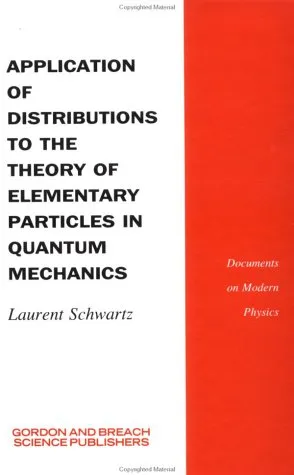Application of Distributions to the Theory of Elementary Particles in Quantum Mechanics (Documents on Modern Physics)
4.0
Reviews from our users

You Can Ask your questions from this book's AI after Login
Each download or ask from book AI costs 2 points. To earn more free points, please visit the Points Guide Page and complete some valuable actions.Introduction to "Application of Distributions to the Theory of Elementary Particles in Quantum Mechanics"
The science of quantum mechanics has revolutionized our understanding of the universe at the smallest scales, but its mathematical underpinning can often be daunting. My book, "Application of Distributions to the Theory of Elementary Particles in Quantum Mechanics," dives into one of the crucial mathematical tools used in modern physics — the theory of distributions — and explicates how it provides a robust framework for addressing complex problems in quantum mechanics, particularly those concerning elementary particles. This text represents a pivotal intersection of theoretical physics and functional analysis, offering readers insights into the application of distributions as tools for solving challenges in particle physics.
Written for physicists and mathematicians alike, this book builds on my foundational work in the mathematics of distributions, which formalized a generalization of classical calculus. It couples that powerful theory with the principles of quantum mechanics to handle singularities, delta functions, and other nuances that arise naturally in describing subatomic particles. Delving into this book equips the reader with both conceptual understanding and practical methodologies to handle some of the most critical problems that emerge at the cutting edge of quantum mechanical theory.
Below, I provide a detailed overview of the book, the key takeaways, a few notable quotes, and why this book stands as a crucial contribution to the advancement of modern physics.
Detailed Summary of the Book
The book is structured to guide you through the primary mathematical tools required to approach quantum mechanical systems, beginning with an introduction to the theory of distributions and then systematically integrating it into the language of quantum mechanics. Distributions, which extend the classical notion of functions, are vital when dealing with irregular objects such as Dirac delta functions, which frequently arise in quantum field theory and the description of particle interactions.
I emphasize the utility of distributions in providing rigorous definitions for quantities in physics that are typically taken as heuristic approximations. From discussing wave-particle duality to Schrödinger's equation and beyond, this book demonstrates how to construct solutions with careful attention to the mathematical rigor often overlooked in purely physical treatments. The final chapters delve into applications of these principles in quantum field theory, exploring how distributions can simplify and clarify the computations related to Feynman propagators and scattering matrices.
The unifying thread of the book lies in its ability to show how an abstract mathematical notion — the distribution — becomes a natural language for tackling the most challenging problems of elementary particle physics. Through illustrative examples, the interaction of mathematics and physics is revealed, demonstrating a profound elegance in the workings of the physical universe.
Key Takeaways
- Understanding Distributions: Gain a deep understanding of the theory of distributions and its applications in solving problems that classical calculus cannot address.
- Rigorous Approach to Quantum Mechanics: Learn how to describe quantum mechanical systems using a more sophisticated and rigorous mathematical framework.
- Connection Between Mathematics and Physics: Appreciate the interplay between abstract mathematics and its tangible applications in nuclear and particle physics.
- Application to Modern Physics: See how quantum field theory and the interaction of elementary particles benefit from the clarity provided by distribution theory.
- Foundations for Advanced Research: Build a solid foundation for future explorations in both theoretical physics and applied mathematics.
Famous Quotes from the Book
"In the subatomic world, where infinities and singularities dominate, the tools of traditional calculus falter, and it is here that distributions shine, illuminating an otherwise opaque mathematical landscape."
"Physics may suggest answers, but mathematics provides the precision to make those answers meaningful."
"Distributions are more than a tool; they are a language — the language of the quantum domain."
Why This Book Matters
This book plays a crucial role in bridging the gap between physicists and mathematicians by providing a common language — the theory of distributions — to describe phenomena that are otherwise handled with approximation and assumptions. In quantum mechanics, where the behavior of particles borders on paradoxical, a rigorous and unified framework is essential for ensuring clarity and consistency.
Furthermore, the insights within this text help to resolve practical challenges that scientists face during research into subatomic particles and their properties. The methodology presented enables precise calculation of scattering amplitudes, analysis of wavefunctions, and even explanations of physical behaviors that classical models fail to account for.
By unveiling the latent potential of distributions in quantum mechanics, this book not only contributes to academic progress but also lays the foundation for technological advancements that rely on quantum theories — from quantum computing to advanced materials science. It is essential for any physicist or mathematician seeking to engage deeply with the conceptual and practical domains of modern quantum mechanics.
Free Direct Download
You Can Download this book after Login
Accessing books through legal platforms and public libraries not only supports the rights of authors and publishers but also contributes to the sustainability of reading culture. Before downloading, please take a moment to consider these options.
Find this book on other platforms:
WorldCat helps you find books in libraries worldwide.
See ratings, reviews, and discussions on Goodreads.
Find and buy rare or used books on AbeBooks.
1251
بازدید4.0
امتیاز50
نظر98%
رضایتReviews:
4.0
Based on 0 users review
"کیفیت چاپ عالی بود، خیلی راضیام"
Questions & Answers
Ask questions about this book or help others by answering
No questions yet. Be the first to ask!


